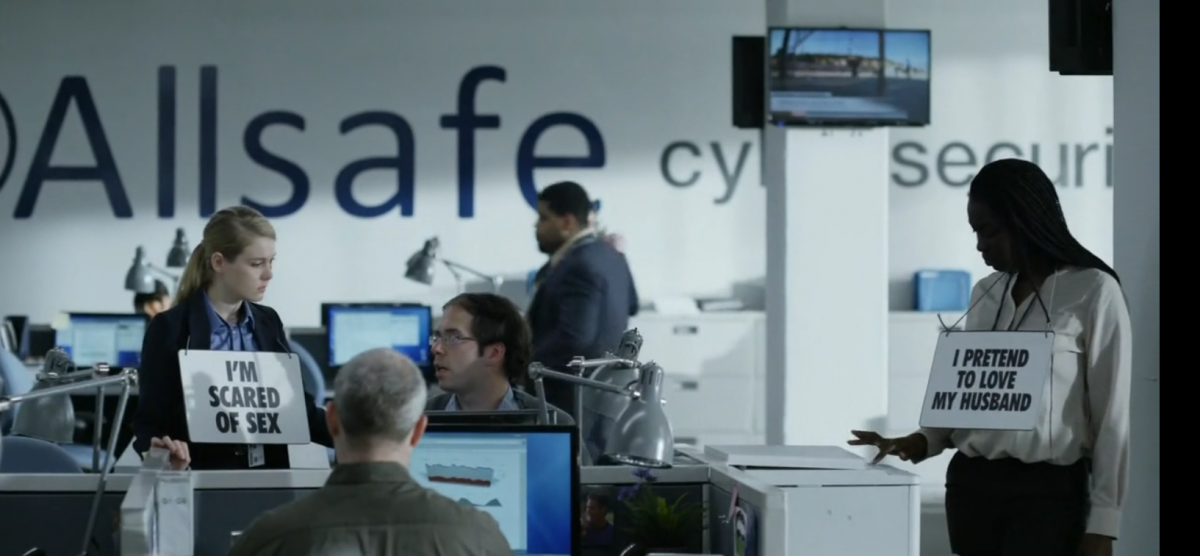Mr. Robot is a veritable referendum on Nic Pizzolatto’s excess and hubris. This is a terrific television series dripping with thrilling depictions of broken and fascinating people that deserves your attention. The show, created by Sam Esmail, is so meticulous in its vision of corporate malfeasance (and those who would exploit the security holes) that it extends its attentions to even the most fleeting of roles, such as the great character actor Tom Ris Farrell as a middle-aged man clutching onto scraps of dignity. Mr. Robot‘s vibrant electronic soundtrack and close verisimilitude of command line moves cements its commitment to the genre of post-cyberpunk, yet the series is even more accomplished in its pursuit of pain and desperation. It has become more poignant and more aware of mortality with each episode.
The show’s heart is steered by Elliot Alderson (played with painstaking fragility by Rami Malek), a techie who works for a security firm called Allsafe. Elliot describes his life through voiceover with dry introspection that could quaver at any minute, one that recalls Edward Norton’s narration in Fight Club. He has an uncertain commitment to revolution, as he dares to fight a two-front war of depression and drug addiction, and an unexamined past populated by demons that he can’t even bring himself to discuss with his therapist. What Elliot does instead is hack into the computers of anyone who enters his life. Elliot’s eyes bulge like an extra terrestrial as he uses credit card items, emails, Twitter accounts, and metadata to piece together these lives on his computer. He burns these details onto discs, labeling each life with an album title. It’s a touching metaphor for the way that an iTunes collection is an insufficient cure for loneliness, yet it doesn’t stop any smartphone addict walking down the street with earbuds perched in her ears.
The show delivers its visuals across an uncanny valley that places subjects to the far edges of the frame. No matter how brilliant our minds or how formidably subcultural our passions, the show’s honest ethos suggests that we can never be the center of any reality. Go the way of normality, whether it be sticking with a putatively loving partner or a commitment to a seemingly respectable firm, and you will find yourself thrown off course by an outside force, whether it be internal corruption, sinister hackers or a creepy Patrick Bateman-like sociopath played with fearsome vivacity by the incredible Martin Wallström. There is an anarchist who goes by the name of Mr. Robot (Christian Slater), who leads a team of hackers that includes a fascinating Iranian Muslim named Mobley who has yet to mention the events of 1979, and hopes to bring the largest corporation in the world (appositely nicknamed “Evil Corp”) to its knees. Mr. Robot is the father figure that Elliot so desperately craves, yet, like most victims, Elliot cannot quite see through Mr.Robot’s violent haze or manipulative motivations. At one point, Mr. Robot pushes Elliot off the edge of a Coney Island railing, leaving him battered for weeks. Of course, Elliot isn’t the only one damaged. There’s Angela Moss, one of Elliot’s coworkers (and a childhood friend), who allowed her philandering boyfriend to install malware on her computer because of his shameless commitment to infidelity. On the more sinister side, there’s Fernando Vera, a drug supplier who first declares to Elliot how his depression is a strength. In the early episodes, I was slightly skeptical with the way that these characters were introduced as cartoonish stock roles. But as the series has gently doled out more character complexity over time, I have come to see these impressions as reflective of Elliot’s view of the universe.
And that’s another quality that’s striking. The show has restyled perfectly safe regions of Manhattan as seedier and more dangerous than they really are, even as it presents authentic drug scenes. Indeed, the show’s commitment to Elliot’s perspective is so liberating and surreal that we see Elliot’s mother force him to eat his pet fish in a fancy restaurant with a design that resembles the Allsafe cubes. Elliot ponders what would happen if people were like webpages. Upon considering whether he can “view source” on others, we see workers sauntering about the corporate office with signs reading I PRETEND TO LOVE MY HUSBAND and I’M EMPTY INSIDE, recalling the subliminal messages in John Carpenter’s They Live.
Some opiners have opted to ascribe a moral imprint upon all this, claiming that Sam Esmail is “playing Sixth Sense-style tricks” on his audience. But this misses the point. Whether “fact” or “fiction,” Elliot’s world is true to his nightmares, even when we witness scenes that he is ostensibly not a part of. And if we know the niceties of Elliot’s shattered existence, maybe we might be tempted to put down our phones and actually talk with the people we judge through social media accounts and shambling about poorly lit cubicles. Perhaps that’s Sam Esmail’s real call for revolution.

An excellent review of a series I’ve already seen and plan to rewatch.
Mr. Robot is easily the best show of 2015 so far.